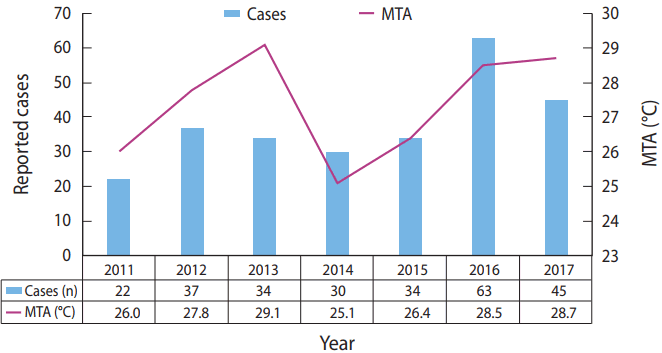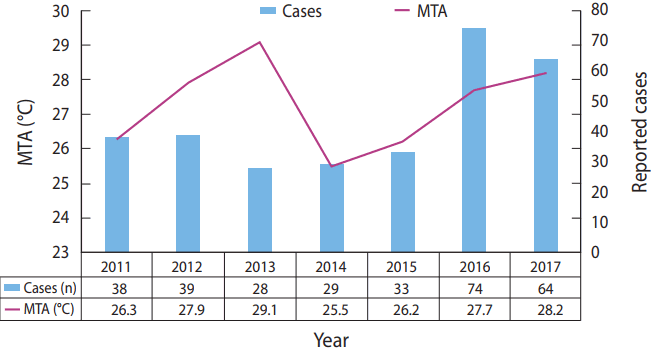Dear Editor,
Lee [1] reported the epidemiological characteristics of scrub typhus cases that occurred from 2011 through 2016 on Jeju Island, and presented a hypothesis that citrus farming is the main risk factor for the infectious disease. However, I found several methodological and logical problems in the process by which the hypothesis was established. In this Letter to the Editor, I summarize the problems into the following 5 categories.
First, the author stated that to examine the incidence of scrub typhus on Jeju Island by year and by region, “the total population of Jeju Island and the population by region were based on the average population from 2011 to 2015 from the National Statistics Office data in Korea.” Based on the statement, it is inferred that the incidence rates presented in Tables 1 and 2, and Figure 1 are crude incidence rates (CIR), and not adjusted for age and sex. If that is CIR, age-adjusted and sex-adjusted incidence rates for comparability should be estimated and the analysis repeated [2]. It is also recommended to compute the 95% confidence intervals (CIs).
Second, the author stated in the Data Analysis section that “The Mann-Whitney U-test was used as a non-parametric measure for comparing 2 independent groups” and showed three p-values in Table 2. He interpreted the first p-value, p= 0.006, in the Results by stating that “there was a statistically significant difference in the incidence of scrub typhus per 100,000 persons between Jeju-si and Seogwipo-si among the urbanized ‘dong’ area regions.” The other two p-values were also similarly interpreted. However, Table 2 lists incidence rates in Jeju and Seogwipo cities across 6 years as the dependent variables. In other words, it seems that the comparison of 2 groups were performed, as stated, but if there were 2 dependent variables by 6 periods respectively, the choice of Mann-Whitney U-test was inappropriate [3]. Additionally, it is recommended to conduct a test for trends.
Third, in the Data Analysis section, the author stated that the Pearson’s chi-square test was performed “to determine if there was a difference between discontinuous variables consisting of an rby-c table.” And, in interpreting the results of the risk factor analysis, he stated that “there was a significant difference in the distribution of outdoor exposures between public health centers.” However, the row in Table 3 included not only the histories of 3 outdoor exposures but also “others,” making it difficult to properly interpret the p-value. If the author conducted “risk factor analysis,” it is recommended to re-categorize outdoor exposures and present prevalence odds ratios as well as their CIs [4].
Fourth, to establish the hypothesis that working at a citrus farm is a risk factor, the author stated in the Discussion that “the unique point was that the infection rate was the highest while working in orchards, and the main related work was mandarin orange farming.” Additionally, the author reported that “78.8% of Agricultural Cooperative mandarin shipment on Jeju Island were reported to have been shipped from Seogwipo-si ‘dong’ area and Namwoneup in Seogwipo East region.” However, the data shown in Table 3 are the number of reported incident cases (i.e., descriptive epidemiology). To make such inference as above, ‘the difference in incidence level between citrus and non-citrus farming’ should be presented. Considering that unlike other regions, farming in Jeju Island is mostly for citrus, the author’s inference lacks evidence, unless the risk of scrub typhus is examined by the type of fruit farming. Just based on the findings in the study, it would be a stretch to argue that citrus farming poses more danger than other types of fruit farming on Jeju Island.
Fifth, the author stated in the Discussion that the high incidence in 2016 has to do with higher levels of mean temperature and dryness in August. However, Park et al. [5] described that it was difficult to identify the relationship between the density of mites and number of reported cases of scrub typhus (NRC) in 2016 even though higher temperature of August as the breeding season of mites is causing the higher density of mites. Thus, it is necessary to review the mean temperatures of August (MTA) from 2011 to 2016 and present relevant evidence. When the weather information provided by Korea Meterological Administration showed that MTA in 2013 was higher than that in 2016 [6]. A correlation analysis between MTA and NRC provided by Korea Centers for Diseases Control and Prevention [7] in 2011-2017 was conducted by Jeju-si and Seogwipo-si. Spearman’s rho and Kendall’s tau-a in Jeju-si were 0.65 (p= 0.12) and 0.48 (p= 0.17), respectively (Figure 1). Same coefficiencies in Seogwipo-si were 0.14 (p= 0.76) and 0.24 (p= 0.55), respectively (Figure 2). Based on these results, it is important to distinguish density of mites from the proportion of mites infected by Oritenta tustusgamushi.
If the aforementioned five issues are not addressed with valid analysis and reasoning, it is difficult to accept the author’s hypothesis from methodological and logical points of view.
ACKNOWLEDGEMENTS
Thanks to Yu Jeong Han as a member of Jeju Center for Infection Control for extracting and arranging the information of the mean temperature of August and the number of cases reported as scrub typhus in Jeju-si and Seogwipo-si.
NOTES
-
The author has no conflicts of interest to declare for this study.
SUPPLEMENTARY MATERIAL
Supplementary material (Korean version) is available at http://www.e-epih.org/.
Figure 1.The reported cases of scrub typhus and mean temperature of August (MTA) in Jeju-si (Spearman’s rho = 0.65, p = 0.12; Kendall’s tau-a = 0.48, p = 0.17).

Figure 2.The reported cases of scrub typhus and mean temperature of August (MTA) in Seogwipo-si (Spearman’s rho = 0.14, p = 0.76; Kendall’s tau-a = 0.24, p = 0.55).

REFERENCES
- 1. Lee SU. Epidemiologic characteristics of scrub typhus on Jeju Island. Epidemiol Health 2017;39:e2017039.ArticlePubMedPMCPDF
- 2. Tiwari RC, Clegg LX, Zou Z. Efficient interval estimation for ageadjusted cancer rates. Stat Methods Med Res 2006;15:547-569.ArticlePubMed
- 3. Nam CM, Chung SY. Statistical methods for medical studies. J Korean Med Assoc 2012;55:573-581 (Korean).Article
- 4. Thompson ML, Myers JE, Kriebel D. Prevalence odds ratio or prevalence ratio in the analysis of cross sectional data: what is to be done? Occup Environ Med 1998;55:272-277.ArticlePubMedPMC
- 5. Park WI, Roh JY, Cho SH. Surveillance of chigger mites as the vector of scrub typhus, 2016. Public Health Wkly Rep 2017;10:1058-1061 (Korean).
- 6. Korea Meteorological Administration. Weather information. [cited 2017 Dec 31]. Available from: https://data.kma.go.kr/data/grnd/selectAsosRltmList.do?pgmNo=36 (Korean).
- 7. Korea Centers for Diseases Control and Prevention. Disease web statistics system. [cited 2017 Dec 31]. Available from: https://is.cdc.go.kr/dstat/jsp/stat/stat0002.jsp (Korean).
Citations
Citations to this article as recorded by

- Epidemiological and Clinical Characteristics of Confirmed Cases of Severe Fever With Thrombocytopenia Syndrome in Jeju Province, Korea, 2014-2018
Jinhee Kim, Jong-Myon Bae
Journal of Preventive Medicine and Public Health.2019; 52(3): 195. CrossRef




 KSE
KSE


 PubReader
PubReader ePub Link
ePub Link Cite
Cite



